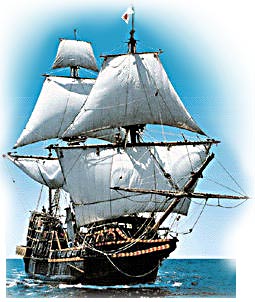2000 YEARS OF SAIL
Sometime in the 13th century shipbuilders stopped using oars as the main way to steer ships and replaced them with a rudder at the stern. Ships were powered by sails, which meant that bigger ships could be built. Throughout the Middle Ages the number of masts and sails increased allowing ships to travel further and change direction in more subtle ways thus opening up the world of exploration and far-flung trade to sailors such as Columbus.
 Very few sailing ships of this time survive but there are some accurate replicas. The Matthew moored in Bristol is a replica of the ship that Englishman John Cabot sailed to Newfoundland in, in 1497, making him the first to discover the Americas in some people’s eyes. While the Golden Hinde in London is a replica of Sir Francis Drake’s vessel in which he circumnavigated the world in 1577-1580.
Very few sailing ships of this time survive but there are some accurate replicas. The Matthew moored in Bristol is a replica of the ship that Englishman John Cabot sailed to Newfoundland in, in 1497, making him the first to discover the Americas in some people’s eyes. While the Golden Hinde in London is a replica of Sir Francis Drake’s vessel in which he circumnavigated the world in 1577-1580.
Towards the end of the Middle Ages warships started to include cannons which changed the nature of sea warfare forever. The biggest and grandest warship was built by Henry VIII. It was called Henri Grace a Dieu or Great Harry. It was the first double-decker warship and weighed over 1000 tons (900 tonnes). It was equipped with heavy cannons and could carry 700 men. It caught fire and sank in 1553 but
another of Henry VIII's warships, the Mary Rose, has been excavated. She is the only
example of a 16th century warship on display in the world.
Britain continued to rely on sail ships for the next 300 years. This was the time of the greatest expansion of the British Empire. Territory after territory was acquired along established trading routes to support Britain’s ever growing commerce. Imposing rigged warships fiercely defended these imperial lands. In 1805 the British Navy won a conclusive victory over the combined Spanish and French fleets in the greatest battle of sail ships of all time – the Battle of Trafalgar. HMS Victory on which the victorious Nelson famously died is a living museum.
During the 19th century Britain’s reliance on commerce meant there was a growing demand for ships that could bring back goods quickly from far-away lands, particularly tea from the East. This led to the age of the elegant Tea Clippers, so called because they could ‘clip’ the time off previous sailings. They had narrow hulls and vast quantities of square sails set in tiers. The best surviving example of a Tea Clipper is the Cutty Sark.
The age of the Tea Clippers, and sailboats in general, was brought to an end with the opening of the Suez Canal in 1869 which allowed large steamships capable of carrying huge cargoes to take a shortcut across the Mediterranean. By the end of the 19th century steam, together with better propellers and improved engine design, had replaced sails.
